Petrogenesis of Eocene Lamprophyre Dykes in Northern Qiangtang Terrane, Tibetan Plateau: Implications for the Tethyan Mantle Metasomatism and Tectonic Evolution
Abstract
:1. Introduction
2. Regional Geology
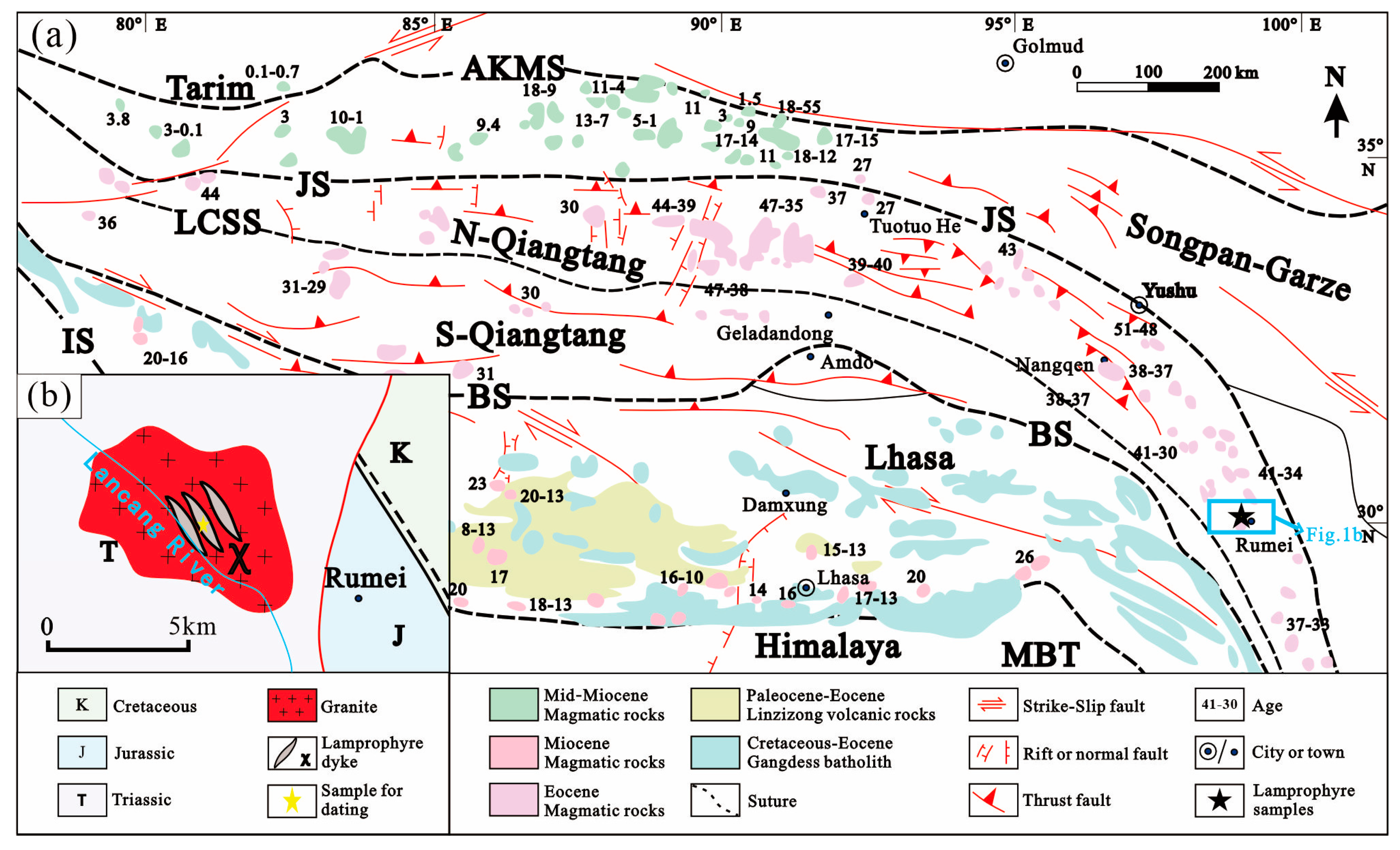
3. Petrology and Petrography
4. Analytical Methods
4.1. Zircon U-Pb Geochronology
4.2. Whole-Rock Geochemistry
4.3. Zircon Lu-Hf Isotopes
5. Results
5.1. Major Elements
5.2. Rare Earth Elements
5.3. Trace Elements
5.4. LA-ICP-MS Zircon U-Pb Isotopic Data
5.5. Zircon Lu-Hf Isotopes
6. Discussion
6.1. Petrogenesis of the Rumei Lamprophyre
6.1.1. Effects of Post-Magmatic Alterations
6.1.2. Crustal Contamination
6.1.3. Magma Source
6.1.4. Mechanisms of Mantle Metasomatism
6.2. Geodynamic Setting
7. Conclusions
- LA-ICP-MS zircon U-Pb dating suggests that the Rumei lamprophyres in the central Tibetan Plateau formed at ca. 39 to 41 Ma.
- The Rumei lamprophyres are pyroxene minettes, which are strongly enriched in LREE and LILEs, depleted in HREE, Nb, Ta and Ti, and enriched in Hf (εHf(t) from −6.40 to 3.80), indicating that the magma source was partially molten phlogopite-bearing garnet lherzolite.
- The petrogenetic analyses show that the potassium enrichment of the Rumei lamprophyres was caused by subduction-related fluids and melts metasomatizing the overlying mantle wedge.
- The Rumei lamprophyres formed as a response to the Neo-Tethys oceanic slab break-off.
Supplementary Materials
Author Contributions
Funding
Data Availability Statement
Acknowledgments
Conflicts of Interest
References
- Zhang, Y.Y.; Guo, Z.J.; Pe-Piper, G.; Piper, D.J.W. Geochemistry and petrogenesis of Early Carboniferous volcanic rocks in East Junggar, North Xinjiang: Implications for post-collisional magmatism and geodynamic process. Gondwana Res. 2015, 28, 1466–1481. [Google Scholar] [CrossRef]
- Zhu, D.C.; Wang, Q.; Cawood, P.A.; Zhao, Z.D.; Mo, X.X. Raising the Gangdese Mountains in southern Tibet. J. Geophys. Res. Solid. Earth. 2017, 122, 214–223. [Google Scholar] [CrossRef]
- Guo, Z.F.; Wilson, M.; Liu, J.Q.; Mao, Q. Post-collisional, potassic and ultrapotassic magmatism of the northern Tibetan Plateau: Constraints on characteristics of the mantle source, geodynamic setting and uplift mechanisms. J. Petrol. 2006, 47, 1177–1220. [Google Scholar] [CrossRef]
- Fan, L.F. Geochemistry of the Cenozoic Bamaoqiongzong volcanic rocks in Qiangtang and its tectonic evolution of lithosphere. Master’ Thesis, Jilin University, Changchun, China, 2015. [Google Scholar]
- Wang, C.S.; Zhao, X.X.; Liu, Z.F.; Lippert, P.C.; Graham, S.A.; Coe, R.S.; Yi, H.S.; Zhu, L.D.; Liu, S.; Li, Y.L. constraints on the early uplift history of the Tibetan Plateau. Proc. Natl. Acad. Sci. USA 2008, 105, 4987–4992. [Google Scholar] [CrossRef] [PubMed]
- Ou, Q.; Wang, Q.; Wyman, D.A.; Zhang, C.F.; Hao, L.L.; Dan, W.; Jiang, Z.Q.; Wu, F.Y.; Yang, J.H.; Zhang, H.X. Postcollisional delamination and partial melting of enriched lithospheric mantle: Evidence from Oligocene (ca. 30 Ma) potassium-rich lavas in the Gemuchaka area of the central Qiangtang Block, Tibet. Geol. Soc. Am. Bull. 2019, 131, 1385–1408. [Google Scholar] [CrossRef]
- Chung, S.L.; Chu, M.F.; Zhang, Y.Q.; Xie, Y.W.; Lo, C.H.; Lee, T.Y.; Lan, C.Y.; Li, X.H.; Zhang, Q.; Wang, Y.Z. Tibetan tectonic evolution inferred from spatial and temporal variations in post-collisional magmatism. Earth-Sci. Rev. 2005, 68, 173–196. [Google Scholar] [CrossRef]
- Kapp, P.; Decelles, P.G. Mesozoic–Cenozoic geological evolution of the Himalayan-Tibetan orogen and working tectonic hypotheses. Am. J. Sci. 2019, 319, 159–254. [Google Scholar] [CrossRef]
- Rohrmann, A.; Kapp, P.; Carrapa, B.; Reiners, P.W.; Guynn, J.; Ding, L.; Heizler, M. Thermochronologic evidence for plateau formation in central Tibet by 45 Ma. Geology 2012, 40, 187–190. [Google Scholar] [CrossRef]
- Prelević, D.; Akal, C.; Foley, S.F.; Romer, R.L.; Stracke, A.; Bogaard, P.V.D. Ultrapotassic Mafic Rocks as Geochemical Proxies for Post-collisional Dynamics of Orogenic Lithospheric Mantle: The Case of Southwestern Anatolia, Turkey. J. Petrol. 2012, 53, 1019–1055. [Google Scholar] [CrossRef]
- Replumaz, A.; Negredo, A.M.; Villasenor, A.; Guillot, S. Indian continental subduction and slab break-off during Tertiary collision. Terra. Nova. 2010, 22, 290–296. [Google Scholar] [CrossRef]
- Zhu, D.C.; Wang, Q.; Zhao, Z.D.; Chung, S.L.; Cawood, P.A.; Niu, Y.; Liu, S.A.; Wu, F.Y.; Mo, X.X. Magmatic record of India-Asia collision. Sci. Rep. 2015, 5, 14289. [Google Scholar] [CrossRef]
- Kay, R.W.; Kay, S.M. Delamination and delamination magmatism. Tectonophysics 1993, 219, 177–189. [Google Scholar] [CrossRef]
- Lu, Y.-J.; McCuaig, T.C.; Li, Z.-X.; Jourdan, F.; Hart, C.J.; Hou, Z.-Q.; Tang, S.-H. Paleogene post-collisional lamprophyres in western Yunnan, western Yangtze Craton: Mantle source and tectonic implications. Lithos 2015, 233, 139–161. [Google Scholar] [CrossRef]
- Zhang, B.; Liu, J.Q.; Chen, W.; Zhu, Z.Y.; Sun, C.Q. Late Eocene magmatism of the eastern Qiangtang block (eastern Tibetan Plateau) and its geodynamic implications. J. Asian Earth Sci. 2020, 195, 104329. [Google Scholar] [CrossRef]
- Lai, S.C.; Qin, J.F. Adakitic rocks derived from the partial melting of subducted continental crust: Evidence from the Eocene volcanic rocks in the northern Qiangtang block. Gondwana Res. 2013, 23, 812–824. [Google Scholar] [CrossRef]
- Long, X.P.; Wilde, S.A.; Wang, Q.; Yuan, C.; Wang, X.C.; Li, J.; Jiang, Z.Q.; Dan, W. Partial melting of thickened continental crust in central Tibet: Evidence from geochemistry and geochronology of Eocene adakitic rhyolites in the northern Qiangtang Terrane. Earth Planet. Sc. Lett. 2015, 414, 30–44. [Google Scholar] [CrossRef]
- Rock, N.M.S. Lamprophyres; Blackie Academic & Professional: London, UK, 1991. [Google Scholar]
- Le, M.R.W. Igneous Rocks: A Classification and Glossary of Terms: Recommendations of the International Union of Geological Sciences Subcommission on the Systematics of Igneous Rocks, 2nd ed.; Cambridge University Press: Cambridge, UK, 2002; pp. 1–236. [Google Scholar]
- Pandey, R.; Rao, N.V.C.; Dhote, P.; Pandit, D.; Choudhary, A.K.; Sahoo, S.; Lehmann, B. Rift-associated ultramafic lamprophyre (damtjernite) from the middle part of the Lower Cretaceous (125 Ma) succession of Kutch, northwestern India: Tectonomagmatic implications. Geosci. Front. 2018, 9, 1883–1902. [Google Scholar] [CrossRef]
- Karsli, O.; Dokuz, A.; Kaliwoda, M.; Uysal, I.; Aydin, F.; Kandemir, R.; Fehr, K.T. Geochemical fingerprints of Late Triassic calc-alkaline lamprophyres from the Eastern Pontides, NE Turkey: A key to understanding lamprophyre formation in a subduction-related environment. Lithos 2014, 196, 181–197. [Google Scholar] [CrossRef]
- Ma, L.; Jiang, S.Y.; Hou, M.L.; Dai, B.Z.; Jiang, Y.H.; Yang, T.; Zhao, K.D.; Pu, W.; Zhu, Z.Y.; Xu, B. Geochemistry of Early Cretaceous calc-alkaline lamprophyres in the Jiaodong Peninsula: Implication for lithospheric evolution of the eastern North China Craton. Gondwana Res. 2014, 25, 859–872. [Google Scholar] [CrossRef]
- Tappe, S.; Smart, K.A.; Stracke, A.; Romer, R.L.; Prelević, D.; Bogaard, P.V.D. Melt evolution beneath a rifted craton edge: 40Ar/39Ar geochronology and Sr–Nd–Hf–Pb isotope systematics of primitive alkaline basalts and lamprophyres from the SW Baltic Shield. Geochim. Cosmochim. Ac. 2016, 173, 1–36. [Google Scholar] [CrossRef]
- Cao, J.; Chen, M.M.; Wan, S.M.; Wang, H.L.; Yi, H.; Lei, H.C. Petrogenesis and Deep Dynamic Processes of Early Permian Alkaline Lamprophyres in the Tarim Large lgneous Province, NW China. Earth Sci. 2023, in press. [Google Scholar]
- Chang, Z.G.; Dong, G.C.; Mo, X.X.; Yin, J.; Dong, P.S. Petrogenesis and tectonic implications of the Late Triassic intrusions in the North China Craton: Case study on the Huata complex in the western Yanshan. Lithos 2022, 430, 106862. [Google Scholar] [CrossRef]
- Hou, Q.; Yang, X.Y.; Tang, J.; Zhou, Q.Z.; Shi, J.B. Geochemistry and geochronology of Early Cretaceous lamprophyres of the Sulu Orogenic Belt: Implications for lithospheric evolution of Eastern China. Int. Geol. Rev. 2022, 65, 1–17. [Google Scholar] [CrossRef]
- Aghazadeh, M.; Prelević, D.; Badrzadeh, Z.; Braschi, E.; Bogaard, P.V.D.; Conticelli, S. Geochemistry, Sr–Nd–Pb isotopes and geochronology of amphibole-and mica-bearing lamprophyres in northwestern Iran: Implications for mantle wedge heterogeneity in a palaeo-subduction zone. Lithos 2015, 216, 352–369. [Google Scholar] [CrossRef]
- Xiong, F.H.; Ma, C.Q.; Jiang, H.A.; Liu, B.; Zhang, J.Y.; Zhou, Q.Z. Petrogenetic and tectonic significance of Permian calc-alkaline lamprophyres, East Kunlun orogenic belt, Northern Qinghai-Tibet Plateau. Int. Geol. Rev. 2013, 55, 1817–1834. [Google Scholar] [CrossRef]
- Xiong, F.H.; Zhong, H.T.; Huang, H.; Liu, X.C.; Hou, M.C. Petrogenetic and tectonic implications of Neoproterozoic igneous rocks from the western Yangtze Block, South China. Precambrian Res. 2023, 387, 106977. [Google Scholar] [CrossRef]
- Wang, L. The mineralogy, geochemistry and source region of agpaitic lamprophyre in Wajilitage, XinJiang. Master’ Thesis, China University of Geosciences, Beijing, China, 2014. [Google Scholar]
- Li, C. The Longmucuo-Shuanghu-Lancangjiang plate suture and the north boundary of distribution of Gondwana facies Permo-Carboniferous system in northern Xizang. China J. Changchun Coll. Geo. 1987, 17, 155–166. [Google Scholar]
- Zhai, Q.G.; Jahn, B.; Su, L.; Wang, J.; Mo, X.X.; Lee, H.Y.; Wang, K.L.; Tang, S.H. Triassic arc magmatism in the Qiangtang area, northern Tibet: Zircon U-Pb ages, geochemical and Sr–Nd–Hf isotopic characteristics, and tectonic implications. J. Asian Earth Sci. 2013, 63, 162–178. [Google Scholar] [CrossRef]
- Kapp, P.; Yin, A.; Manning, C.E.; Murphy, M.; Harrison, T.M.; Spurlin, M.; Ding, L.; Deng, X.G.; Wu, C.M. Blueschist-bearing metamorphic core complexes in the Qiangtang block reveal deep crustal structure of northern Tibet. Geology 2000, 28, 19–22. [Google Scholar] [CrossRef]
- Pullen, A.; Kapp, P.; Gehrels, G.E.; Vervoort, J.D.; Ding, L. Triassic continental subduction in central Tibet and Mediterranean-style closure of the Paleo-Tethys Ocean. Geology 2008, 36, 351–354. [Google Scholar] [CrossRef]
- Ding, L.; Kapp, P.; Zhong, D.; Deng, W.M. Cenozoic volcanism in Tibet: Evidence for a transition from oceanic to continental subduction. J. Petrol. 2003, 44, 1833–1865. [Google Scholar] [CrossRef]
- Liu, J.F.; Chi, X.G.; Zhao, X.Y.; Zhao, Z.; Dong, Y.C.; Li, G.R.; Zhao, Y.D. Chronology, geochemistry and tectonic significances of the Cenozoic Zougouyouchacuo and Nadingcuo volcanic rocks in northern Tibetan Plateau. Acta. Petrol. Sin. 2009, 25, 3259–3274. [Google Scholar]
- Hao, L.L.; Wang, Q.; Kerr, A.C.; Yang, J.-H.; Ma, L.; Qi, Y.; Wang, J.; Ou, Q. Post-collisional crustal thickening and plateau uplift of southern Tibet: Insights from Cenozoic magmatism in the Wuyu area of the eastern Lhasa block. Geol. Soc. Am. Bull. 2021, 133, 1634–1648. [Google Scholar] [CrossRef]
- Xu, C.B.; Zeng, J.P.; Wang, Q.; Zhang, X.Z.; Ou, Q.; Wang, J.; Hao, L.L.; Chen, Y.W. Eocene adakitic quartz monzonites and granite porphyries from the northern Qiangtang Block, central Tibet: Partial melting of sediment-rich mélange? Front Earth Sci. 2022, 10, 953448. [Google Scholar] [CrossRef]
- Zong, K.Q.; Klemd, R.; Yuan, Y.; He, Z.Y.; Guo, J.L.; Shi, X.L.; Liu, Y.S.; Hu, Z.C.; Zhang, Z.M. The assembly of Rodinia: The correlation of early Neoproterozoic (ca. 900 Ma) high-grade metamorphism and continental arc formation in the southern Beishan Orogen, southern Central Asian Orogenic Belt (CAOB). Precambrian Res. 2017, 290, 32–48. [Google Scholar] [CrossRef]
- Wiedenbeck, M.; Alle, P.; Corfu, F.; Griffin, W.L.; Meier, M.; Oberli, F.; Vonquadt, A.; Roddick, J.C.; Speigel, W. Three natural zircon standards for U-Th-Pb, Lu-Hf, trace-element and REE analyses. Geostand. Geoanal. Res. 1995, 19, 1–23. [Google Scholar] [CrossRef]
- Liu, Y.S.; Gao, S.; Hu, Z.C.; Gao, C.G.; Zong, K.Q.; Wang, D.B. Continental and oceanic crust recycling-induced melt–peridotite interactions in the Trans-North China Orogen: U-Pb dating, Hf isotopes and trace elements in zircons from mantle xenoliths. J. Petrol. 2010, 51, 537–571. [Google Scholar] [CrossRef]
- Shan, H.S.; Liu, J.L.; Ding, X.; Chen, X.Y.; Yu, X.Q.; Liu, Z.H.; Xu, Z.Y. Subduction initiation of the Proto-Tethys Ocean that facilitated climate change and biodiversification. Earth Planet Sc Lett. 2022, 600, 117874. [Google Scholar] [CrossRef]
- Ludwig, K.R. User’s Manual for Isoplot/ex Version 3.00: A Geochronological Toolkit for Microsoft Excel; Special Publication; Berkeley Geochronology Center: Berkeley, CA, USA, 2003. [Google Scholar]
- Hu, Z.C.; Liu, Y.S.; Gao, S.; Liu, W.G.; Zhang, W.; Tong, X.R.; Lin, L.; Zong, K.Q.; Li, M.; Chen, H.H.; et al. Improved in situ Hf isotope ratio analysis of zircon using newly designed X skimmer cone and jet sample cone in combination with the addition of nitrogen by laser ablation multiple collector ICP-MS. J. Anal. Atom. Spectrom. 2012, 27, 1391–1399. [Google Scholar] [CrossRef]
- Le, M.R.W.; Bateman, P.; Dudek, A.; Keller, J.; Lameyre, J.; Le, B.M.J.; Sabine, P.A.; Schmid, R.; Sorensen, H.; Streckeisen, A. A classification of igneous rocks and glossary of terms. Recommendations of the IUGS Subcommission on the Systematics of Igneous rocks, 1st ed.; Blackwell: Oxford, UK, 1989; pp. 130–171. [Google Scholar]
- Middlemost, E.A.K. Naming materials in the magma/igneous rock system. Earth. Sci. Rev. 1994, 37, 215–224. [Google Scholar] [CrossRef]
- Rock, N.M.S. The Nature and Origin of Lamprophyres: An Overview. In Magmatism in the Ocean Basins; Special Publications; Saunders, A.D., Norry, M.J., Eds.; Geological Society: London, UK, 1987; Volume 30, pp. 191–226. [Google Scholar]
- Sun, S.S.; McDonough, W.F. Chemical and isotopic systematics of oceanic basalts: Implications for mantle composition and processes. In Magmatism in the Ocean Basins; Special Publications; Saunders, A.D., Norry, M.J., Eds.; Geological Society: London, UK, 1989; Volume 42, pp. 313–345. [Google Scholar]
- Niu, Y.L.; Gilmore, T.; Mackie, S.; Greig, A.; Bach, W. Mineral chemistry, whole-rock compositions, and petrogenesis of Leg 176 gabbros: Data and discussion. In Proceedings of the Ocean Drilling Program, Scientific Results; Ocean Drilling Program: College Station, TX, USA, 2002. [Google Scholar]
- Niu, Y.L.; Regelous, M.; Wendt, I.J.; Batiza, R.; O’hara, M.J. Geochemistry of near-EPR seamounts: Importance of source vs. process and the origin of enriched mantle component. Earth. Planet. Sci. Lett. 2002, 199, 327–345. [Google Scholar] [CrossRef]
- Kelemen, P.B.; Hanghøj, K.; Greene, A.R. One view of the geochemistry of subduction-related magmatic arcs, with an emphasis on primitive andesite and lower crust. In Treatise on Geochemistry; Holland, H.D., Turekian, K.K., Eds.; Elsevier: Amsterdam, Netherlands, 2007; Volume 3, pp. 1–70. [Google Scholar]
- Lai, S.C.; Qin, J.F.; Li, Y.F.; Long, P. Geochemistry and petrogenesis of the alkaline and cale-alkaline series Cenozoic volcanic rocks from Huochetou mountain, Tibetan plateau. Acta. Petrol. Sin. 2007, 23, 709–718. [Google Scholar]
- Wu, F.Y.; Yang, Y.H.; Xie, L.W.; Yang, J.H.; Xu, P. Hf isotopic compositions of the standard zircons and baddeleyites used in U-Pb geochronology. Chem. Geol. 2006, 234, 105–126. [Google Scholar] [CrossRef]
- Lu, Y.J.; Kerrich, R.; Mccuaig, T.C.; Li, Z.X.; Hart, C.J.R.; Cawood, P.A.; Hou, Z.Q.; Bagas, L.; Cliff, J.; Belousova, E.A.; et al. Geochemical, Sr-Nd-Pb, and Zircon Hf-O Isotopic Compositions of Eocene-Oligocene Shoshonitic and Potassic Adakite-like Felsic Intrusions in Western Yunnan, SW China: Petrogenesis and Tectonic Implications. J. Petrol. 2013, 54, 1309–1348. [Google Scholar] [CrossRef]
- Liu, J.H.; Gou, G.N.; Wang, Q.; Zhang, X.Z.; Guo, H.F. Petrogenesis of Eocene high-silica granites in the Maliaoshan area, northern Tibet: Implications for the Eocene magmatic flare-up in the Northern Qiangtang Block. J. Asian. Earth. Sci. 2022, 234, 105268. [Google Scholar] [CrossRef]
- Qian, Y.; Tian, S.N.; Li, Y.J.; Sun, F.Y.G. Zircon U-Pb age and geochemical constraints on the origin and tectonic implication of the Tuotuohe Cenozoic alkaline magmatism in Qinghai–Tibet Plateau. Acta Geochim. 2020, 39, 67–84. [Google Scholar] [CrossRef]
- Zeng, Y.C.; Xu, J.F.; Li, M.J.; Chen, J.L.; Wang, B.D.; Huang, F.; Ren, S.H. Late Eocene two-pyroxene trachydacites from the southern Qiangtang Terrane, central Tibetan Plateau: High-temperature melting of overthickened and dehydrated lower crust. J. Petrol. 2021, 62, egab080. [Google Scholar] [CrossRef]
- Zhao, Z.; Chi, X.G.; Liu, J.F.; Li, G.R.; Zhao, Y.D. Geochemical feature and its tectonic significance of Gemucuo Oligocene potassic volcanic rocks in the Qiangtang area, Tibet, China. Geol. Bull. China 2009, 28, 463–473. [Google Scholar]
- Liu, S.; Hu, R.Z.; Chi, X.G.; Li, C.; Feng, C.X.; Wang, T.W. Post-collisional ultrapotassic volcanic rocks in Qiangtang rock belt. Geotec. Metallo. 2003, 27, 167–175. [Google Scholar]
- Qin, Z.P.; Du, Q.D.; Zhang, G.Y.; Duo, J.; Li, M.; Huang, C. Origin and tectonic significance of Eocene sodic lamprophyres in the Southern Qiangtang Orogen, Tibet. J. Asian Earth Sci. 2023, 250, 105629. [Google Scholar] [CrossRef]
- Liu, D.L.; Shi, R.D.; Ding, L.; Huang, Q.S.; Zhang, X.R.; Yue, Y.H.; Zhang, L.Y. Zircon U-Pb age and Hf isotopic compositions of Mesozoic granitoids in southern Qiangtang, Tibet: Implications for the subduction of the Bangong–Nujiang Tethyan Ocean. Gondwana Res. 2017, 41, 157–172. [Google Scholar] [CrossRef]
- Rudnick, R.; Gao, S. Composition of the continental crust. In Treatise on Geochemistry; Holland, H.D., Turekian, K.K., Eds.; Elsevier-Pergamon: Oxford, UK, 2003; Volume 3, pp. 1–64. [Google Scholar]
- Nicholls, I.A.; Harris, K.L. Experimental rare earth element partition coefficients for garnet, clinopyroxene and amphibole coexisting with andesitic and basaltic liquids. Geochim. Cosmochim. Acta 1980, 44, 287–308. [Google Scholar] [CrossRef]
- Foley, S.F.; Jackson, S.E.; Fryer, B.J.; Greenouch, J.D.; Jenner, G.A. Trace element partition coefficients for clinopyroxene and phlogopite in an alkaline lamprophyre from Newfoundland by LAM-ICP-MS. Geochim. Cosmochim. Acta 1996, 60, 629–638. [Google Scholar] [CrossRef]
- Latourrette, T.; Hervig, R.L.; Holloway, J.R. Trace element partitioning between amphibole, phlogopite, and basanite melt. Earth Planet. Sc. Lett. 1995, 135, 13–30. [Google Scholar] [CrossRef]
- Adam, J.; Green, T.H.; Sie, S.H. Proton microprobe determined partitioning of Rb, Sr, Ba, Y, Zr, Nb and Ta between experimentally produced amphiboles and silicate melts with variable F content. Chem. Geol. 1993, 109, 29–49. [Google Scholar] [CrossRef]
- Ma, L.; Jiang, S.Y.; Hofmann, A.W.; Dai, B.Z.; Hou, M.L.; Zhao, K.D.; Chen, L.H.; Li, J.W.; Jiang, Y.H. Lithospheric and asthenospheric sources of lamprophyres in the Jiaodong Peninsula: A consequence of rapid lithospheric thinning beneath the North China Craton? Geochim. Cosmochim. Acta 2014, 124, 250–271. [Google Scholar] [CrossRef]
- Furman, T.; Graham, D. Erosion of lithospheric mantle beneath the East African Rift system: Geochemical evidence from the Kivu volcanic province. In Developments in Geotectonics; Elsevier: Amsterdam, Netherlands, 1999; Volume 24, pp. 237–262. [Google Scholar]
- Wang, K.; Plank, T.; Walker, J.D.; Smith, E.I. A mantle melting profile across the Basin and Range, SW USA. J. Geophys. Res. Sol. Earth. 2002, 107, ECV 5-1–ECV 5-21. [Google Scholar] [CrossRef]
- Wang, C.; Liu, H.; Feng, H.B.; Deng, J.H.; Liu, X.F.; Zhao, F.F. Geochemistry and U-Pb ages of the diabases from the Luoji area, western Yunnan, China: Implications for the timing of initial rifting of the Ganzi-Litang Ocean. Geol. Croat. 2019, 72, 19–32. [Google Scholar] [CrossRef]
- Ning, W.K.; Chi, X.G.; Liu, J.F.; Zhao, Z.; Li, C. Genesis of Heishibeihu Cenozoic potassic volcanic rocks from northern Qing-hai-Tibet Plateau China. Geol. Bull. China 2009, 28, 1355–1360. [Google Scholar]
- Pearce, J.A. Geochemical fingerprinting of oceanic basalts with applications to ophiolite classification and the search for Archean oceanic crust. Lithos 2008, 100, 14–48. [Google Scholar] [CrossRef]
- Class, C.; Miller, D.M.; Goldstein, S.L.; Langmuir, C.H. Distinguishing melt and fluid subduction components in Umnak Volcanics, Aleutian Arc. Geochem. Geophy. Geosy. 2000, 1. [Google Scholar] [CrossRef]
- Castillo, P.R.; Rigby, S.J.; Solidum, R.U. Origin of high field strength element enrichment in volcanic arcs: Geochemical evidence from the Sulu Arc, southern Philippines. Lithos 2007, 97, 271–288. [Google Scholar] [CrossRef]
- Castillo, P.; Newhall, C. Geochemical constraints on possible subduction components in lavas of Mayon and Taal volcanoes, southern Luzon, Philippines. J. Petrol. 2004, 45, 1089–1108. [Google Scholar] [CrossRef]
- Hermann, J.; Green, D.H. Experimental constraints on high pressure melting in subducted crust. Earth. Planet. Sci. Lett. 2001, 188, 149–168. [Google Scholar] [CrossRef]
- Pearce, J.A. Trace element characteristics of lavas from destructive plate boundaries. In Andesites: Orogenic Andesites and Related Rocks; Thorpe, R.S., Ed.; Wiley: Hoboken, NJ, USA, 1982; pp. 528–548. [Google Scholar]
- Zhao, Z.D.; Mo, X.X.; Dilek, Y.; Niu, Y.L.; Depaolo, D.J.; Robinson, P.; Zhu, D.C.; Sun, C.G.; Dong, G.C.; Zhou, S. Geochemical and Sr–Nd–Pb–O isotopic compositions of the post-collisional ultrapotassic magmatism in SW Tibet: Petrogenesis and implications for India intra-continental subduction beneath southern Tibet. Lithos 2009, 113, 190–212. [Google Scholar] [CrossRef]
- He, X.; Wang, W.; Santosh, M.; Yao, J.C.; Gao, K.T.; Zhang, Y.H.; Lu, D.G.; Guo, L.S. Late Neoarchean crustal growth under paired continental arc-back arc system in the North China Craton. Geosci. Front. 2021, 12, 101120. [Google Scholar] [CrossRef]
- Guo, Z.F.; Wilson, M.; Zhang, M.L.; Cheng, Z.H.; Zhang, L.H. Post-collisional ultrapotassic mafic magmatism in South Tibet: Products of partial melting of pyroxenite in the mantle wedge induced by roll-back and delamination of the subducted Indian continental lithosphere slab. J. Petrol. 2015, 56, 1365–1406. [Google Scholar] [CrossRef]
- Chakrabarti, R.; Basu, A.R.; Santo, A.P.; Tedesco, D.; Vaselli, O. Isotopic and geochemical evidence for a heterogeneous mantle plume origin of the Virunga volcanics, Western rift, East African Rift system. Chem. Geol. 2009, 259, 273–289. [Google Scholar] [CrossRef]
- Wang, Q.; Wyman, D.A.; Li, Z.X.; Sun, W.D.; Chung, S.L.; Vasconcelos, P.M.; Zhang, Q.Y.; Dong, H.; Yu, Y.S.; Pearson, N. Eocene north–south trending dikes in central Tibet: New constraints on the timing of east–west extension with implications for early plateau uplift? Earth Planet. Sci. Lett. 2010, 298, 205–216. [Google Scholar] [CrossRef]
- Pan, G.T.; Wang, P.S.; Xu, Y.R. Cenozoic Tectonic Evolution of Qinghai-Tibet Plateau; Geology Press: Beijing, China, 1990; pp. 1–190. [Google Scholar]
- Wang, Q.; Wyman, D.A.; Xu, J.F.; Dong, Y.H.; Vasconcelos, P.M.; Pearson, N.; Wan, Y.S.; Dong, H.; Li, C.F.; Yu, Y.S.; et al. Eocene melting of subducting continental crust and early uplifting of central Tibet: Evidence from central-western Qiangtang high-K calc-alkaline andesites, dacites and rhyolites. Earth Planet. Sci. Lett. 2008, 272, 158–171. [Google Scholar] [CrossRef]
- Ou, Q.; Wang, Q.; Wyman, D.A.; Zhang, H.X.; Yang, J.H.; Zeng, J.P.; Hao, L.L.; Chen, Y.W.; Liang, H.; Qi, Y. Eocene adakitic porphyries in the central-northern Qiangtang Block, central Tibet: Partial melting of thickened lower crust and implications for initial surface uplifting of the plateau. J. Geophys. Res. Sol. Earth 2017, 122, 1025–1053. [Google Scholar] [CrossRef]
- Zhang, R. Volcanic Rocks from Qiangtang, Northern TibetPetrogenesis of the Cenozoic Alkaline Potassic-Ultrapotassic. Ph.D. Thesis, Jilin University, Changchun, China, 2018. [Google Scholar]

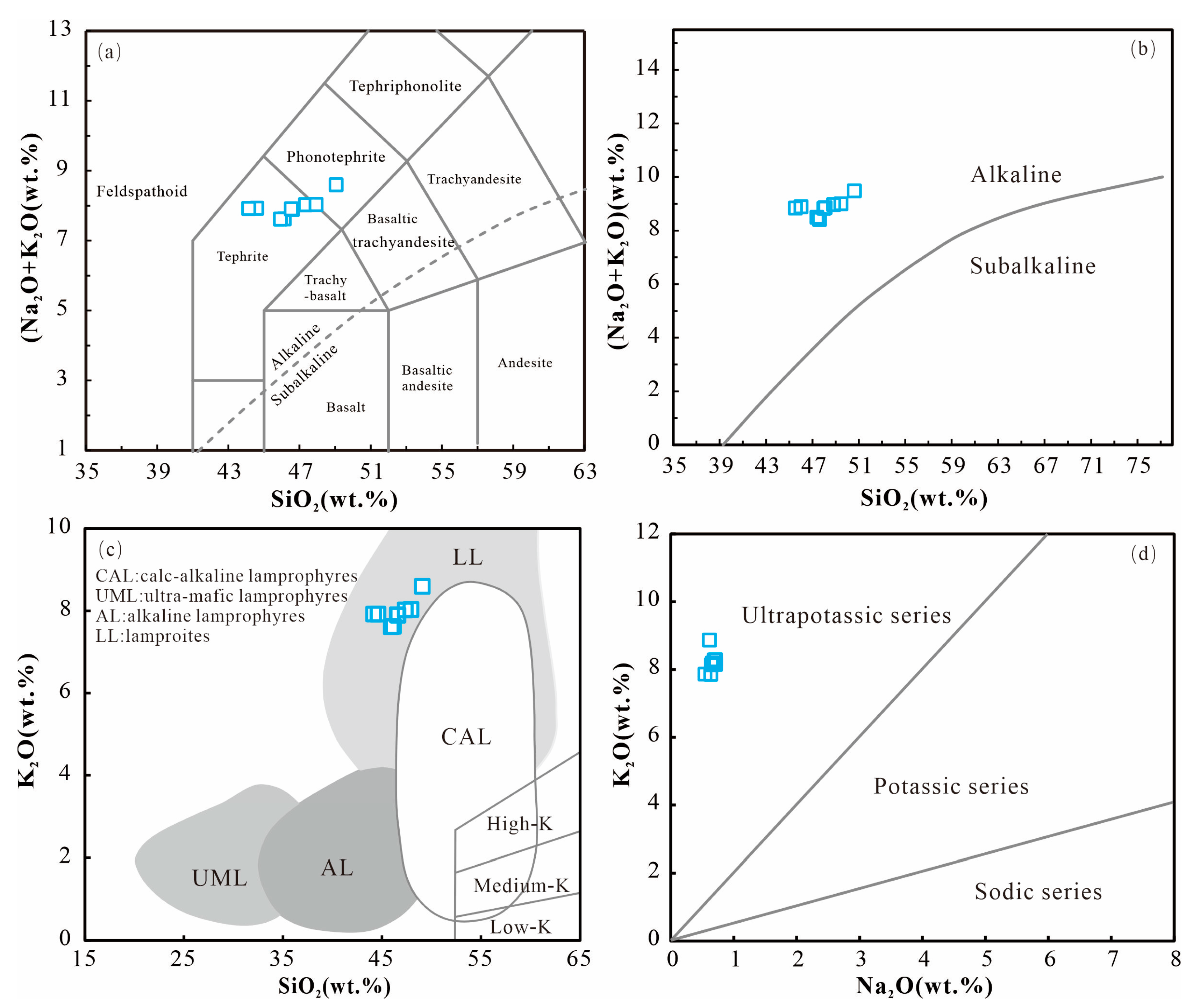
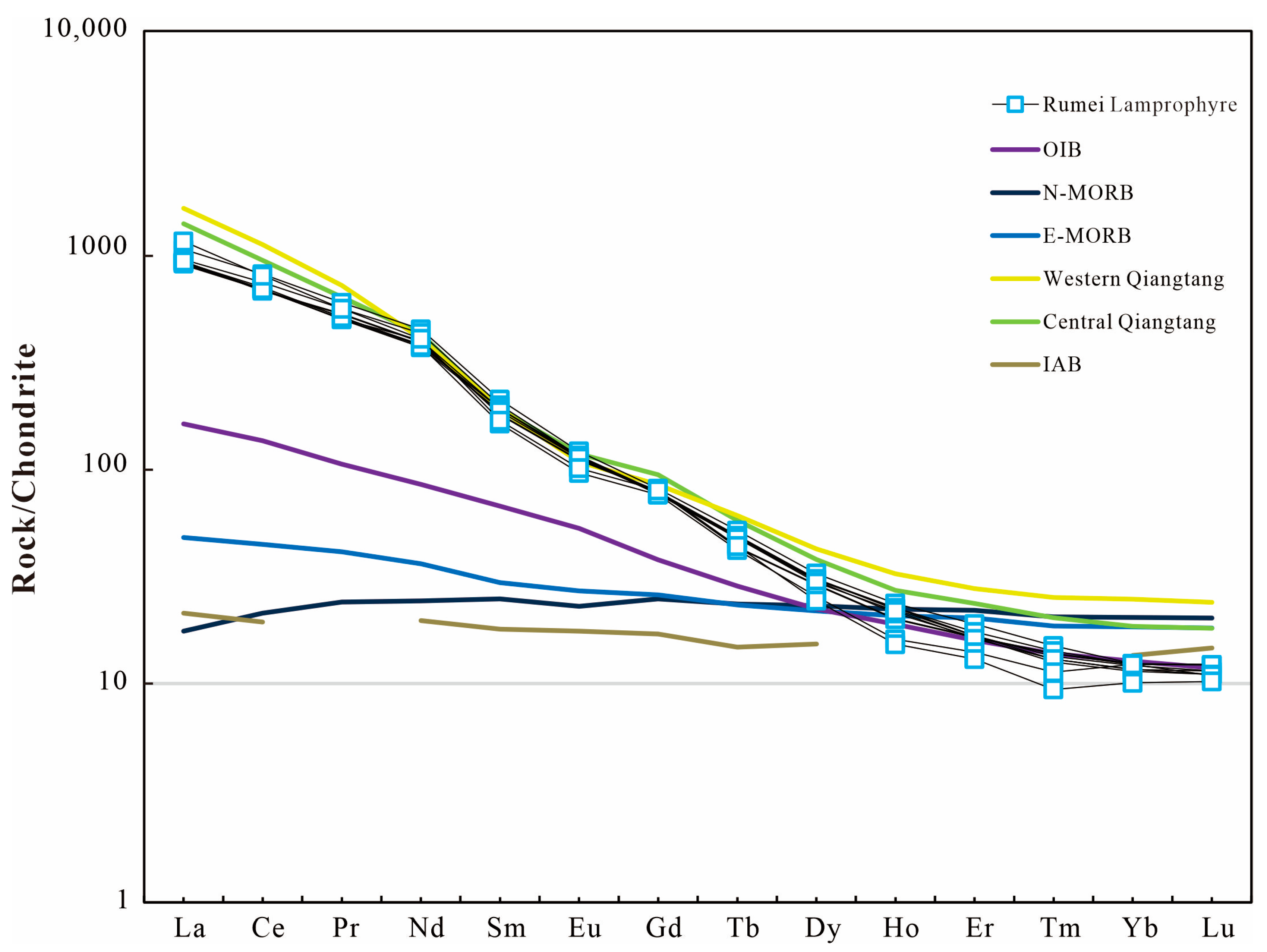
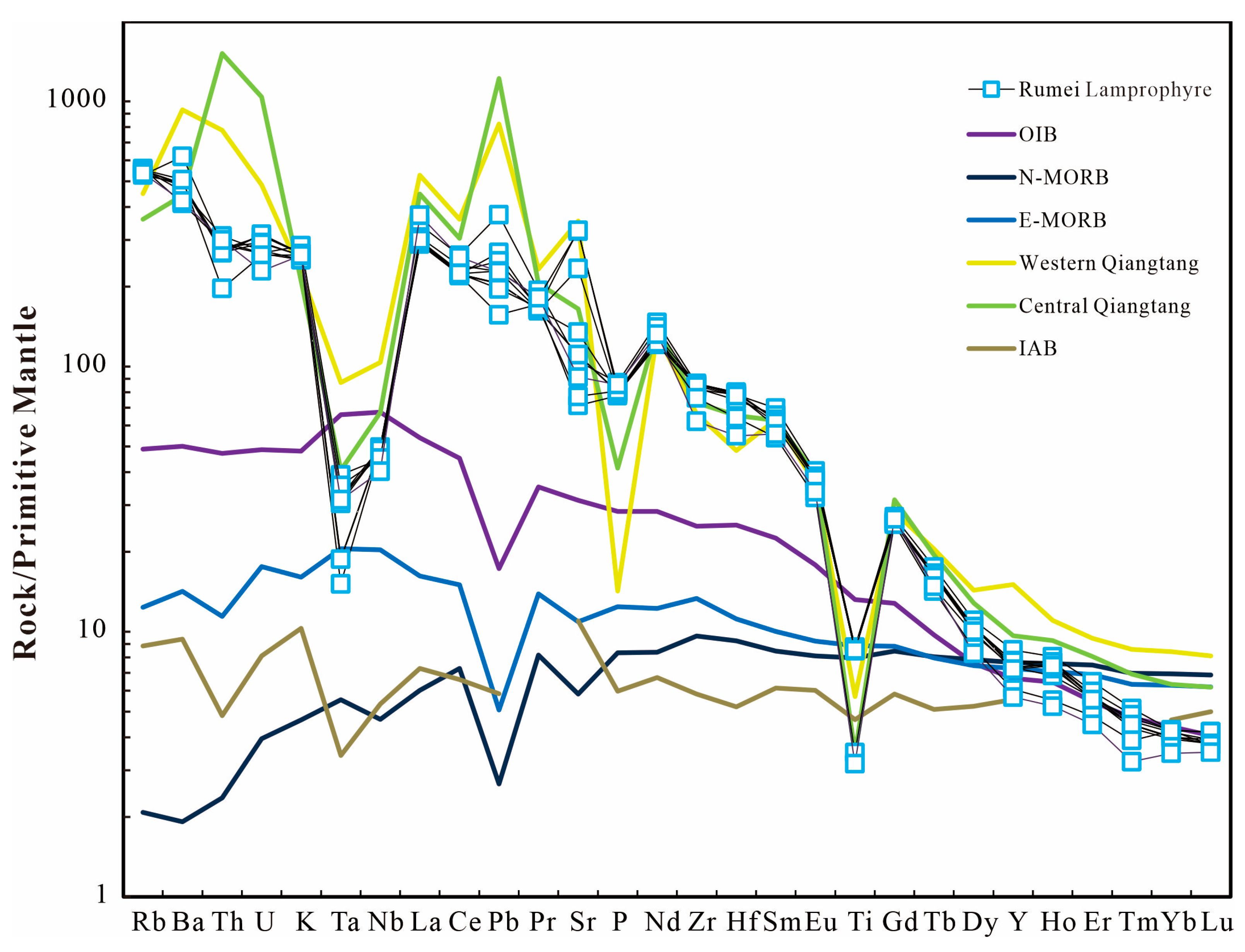

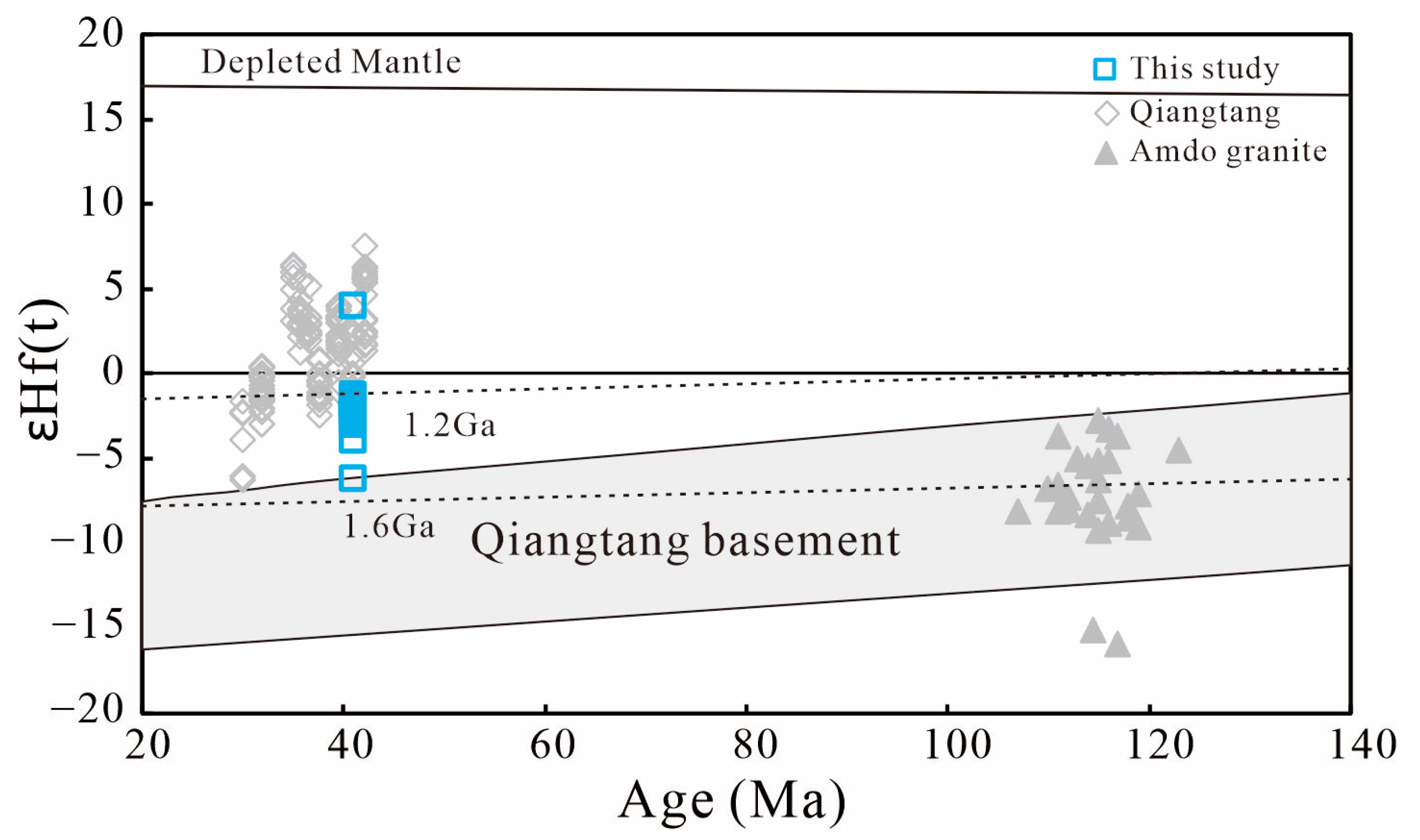
Disclaimer/Publisher’s Note: The statements, opinions and data contained in all publications are solely those of the individual author(s) and contributor(s) and not of MDPI and/or the editor(s). MDPI and/or the editor(s) disclaim responsibility for any injury to people or property resulting from any ideas, methods, instructions or products referred to in the content. |
© 2023 by the authors. Licensee MDPI, Basel, Switzerland. This article is an open access article distributed under the terms and conditions of the Creative Commons Attribution (CC BY) license (https://creativecommons.org/licenses/by/4.0/).
Share and Cite
Zeng, X.; Gong, T.; Zhao, H.; Xiong, F. Petrogenesis of Eocene Lamprophyre Dykes in Northern Qiangtang Terrane, Tibetan Plateau: Implications for the Tethyan Mantle Metasomatism and Tectonic Evolution. Minerals 2023, 13, 1349. https://doi.org/10.3390/min13101349
Zeng X, Gong T, Zhao H, Xiong F. Petrogenesis of Eocene Lamprophyre Dykes in Northern Qiangtang Terrane, Tibetan Plateau: Implications for the Tethyan Mantle Metasomatism and Tectonic Evolution. Minerals. 2023; 13(10):1349. https://doi.org/10.3390/min13101349
Chicago/Turabian StyleZeng, Xiaohui, Tingting Gong, Han Zhao, and Fuhao Xiong. 2023. "Petrogenesis of Eocene Lamprophyre Dykes in Northern Qiangtang Terrane, Tibetan Plateau: Implications for the Tethyan Mantle Metasomatism and Tectonic Evolution" Minerals 13, no. 10: 1349. https://doi.org/10.3390/min13101349







